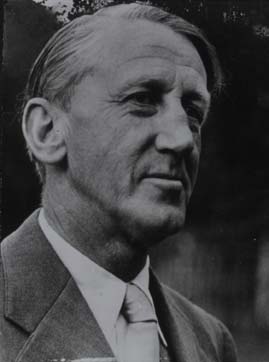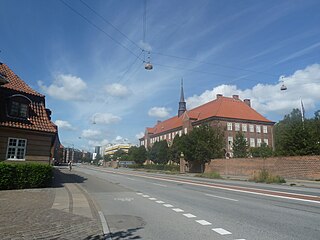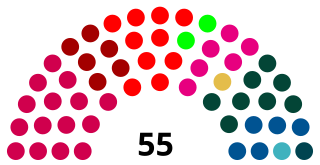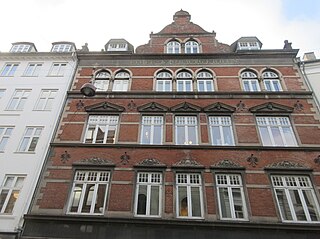
Assistens Cemetery in Copenhagen, Denmark, is the burial site of many Danish notables as well as an important greenspace in the Nørrebro district. Inaugurated in 1760, it was originally a burial site for the poor laid out to relieve the crowded graveyards inside the walled city, but during the Golden Age in the first half of the 19th century it became fashionable and many leading figures of the epoch, such as Hans Christian Andersen, Søren Kierkegaard, Christoffer Wilhelm Eckersberg, and Christen Købke are all buried here.

Kaare Klint was a Danish architect and furniture designer, known as the father of modern Danish furniture design. His style was epitomized by clean, pure lines, use of the best materials of his time and superb craftsmanship.

Peder Vilhelm Jensen-Klint was a Danish architect, designer, painter and architectural theorist, best known for designing Grundtvig's Church in Copenhagen, generally considered to be one of the most important Danish architectural works of the time. Its Expressionist style relies heavily on Scandinavian brick Gothic traditions.

Grundtvig's Church is located in the Bispebjerg district of Copenhagen, Denmark. It is a rare example of expressionist church architecture. Due to its originality, it is one of the best known churches in the city.

Ivar Bentsen was a Danish architect and educator. He was a central figure in the Bedre-Byggeskik movement and succeeded Carl Petersen as a professor at the Royal Danish Academy of Fine Arts's School of Architecture in 1923. He was awarded the C. F. Hansen Medal in 1943.

Amagertorv is a public square in the district of Indre By in central Copenhagen, Denmark. Today it forms part of the Strøget pedestrian zone, and is often described as the most central square in Copenhagen. Second only to Gammeltorv, it is also one of the oldest, taking its name from the Amager farmers who in the Middle Ages came into town to sell their produce at the site.

Gedser Church lies in the town of Gedser on the southern tip of the Danish island of Falster. It is the church of Gedser Parish. Completed in 1915, it was designed by Peder Vilhelm Jensen-Klint, best known for designing Grundtvig's Church in Copenhagen.

Christian Gottlieb Vilhelm Bissen was a Danish sculptor. He was also a professor at the Royal Danish Academy of Fine Arts with great influence on the next generation of Danish sculptors and for a while served as its director. Bissen was trained in the Neoclassical tradition from Bertel Thorvaldsen but after a stay in Paris around 1880, he was influenced by Naturalism. With the equestrian statue of Absalon he turned to Neo-romanticism.

Edvard Petersen was a Danish painter. He also designed the Stork Fountain on Amagertorv in Copenhagen.

Anna Church is a Lutheran church in the Nørrebro district of Copenhagen, Denmark. It was designed by Peder Vilhelm Jensen-Klint, best known for his design of Grundtvig's Church, also in Copenhagen. Built in three stages, it was completed between 1914 and 1928.

Trianglen is a central junction and public space in the Østerbro district of Copenhagen, Denmark. Five streets meet in the junction: Blegdamsvej, Øster Allé, Østerbrogade, Nordre Frihavnsgade and Odensegade. Trianglen is a station on the City Circle Line of the Copenhagen Metro.

Åboulevard is a street in central Copenhagen, Denmark. Together with H. C. Andersens Boulevard in the city centre and Borups Allé, it forms a major artery in and out of the city. The road is built over Ladegårds Å, a canal originally built to supply Copenhagen with water, which still runs in a pipe under it, feeding water into Peblinge Lake.

The Dragon Fountain is a fountain located in the City Hall Square in Copenhagen, Denmark. It was designed by Joakim Skovgaard in collaboration with Thorvald Bindesbøll and features a bull in combat with a dragon.

Tagensvej is a major street in the northwestern part of inner Copenhagen, Denmark. It runs from Blegdamsvej on the border between Nørrebro and Østerbro in the southeast to Frederiksborgvej and Bispebjerg Cemetery in the northwest.
Vodroffsvej is a street in the Frederiksberg district of Copenhagen, Denmark. It follows the western shore of St. Jørgen's Lake, linking Gammel Kongevej in the south with Rosenørns Allé in the north. The embankment and lakeside path on the east side of the street is called Svineryggen.

Frederiksborggade is a street in central Copenhagen, Denmark. It runs from Kultorvet square in the southeast to Søtorvet where Queen Louise's Bridge connects it to Nørrebrogade in Nørrebro on the other side of The Lakes. The street is effectively divided in two by Nørreport station on Nørre Voldgade. The short, southern portion, together with Kultorvet and Købmagergade, forms a pedestrian zone between the station and Strøget at Amagertorv. The wider and younger northern portion is open to car traffic.

The Copenhagen City Council is the municipal government of Copenhagen, Denmark, and has its seat at Copenhagen City Hall.

Lille Købmagerhus is a Renaissance Revival style building situated on Købmagergade in Copenhagen, Denmark. It was constructed in c. 1800 for coffee retailer Christian P Hansen to designs by architect A. B. C. von Düben. The inclusion of "Lille" in its name destinguishes it from the slightly older and somewhat larger Købmagerhus further down the street. Peder Hvitfeldts Stræde 4, a three-storey building from 1812 on the other side of the block, is also part of the property. Notable former residents of Peder Hvidtfeldts Stræde 4 include the philosopher Frederik Christian Sibbern, botanist and politicianJoakim Frederik Schouw and architectPeter Kornerup. The property is today owned by Kirkebi A/S.

The Statue of N. F. S, Grundtvig, situated in the central courtyard of Vartorv, close to the City Hall Square in central Copenhagen, Denmark, was created by Niels Skovgaard. It depicts N. F. S. Grundtvig knealing by the Spring of Life.




















